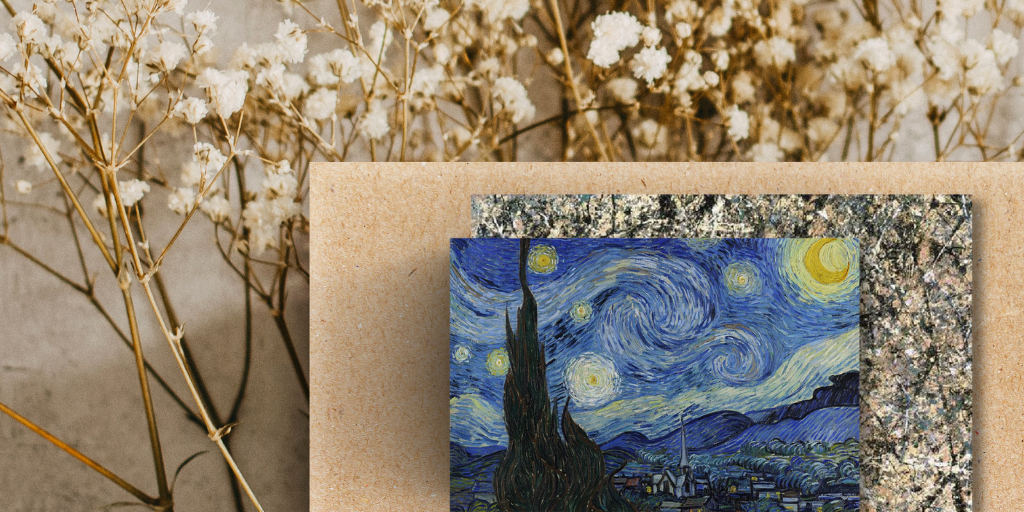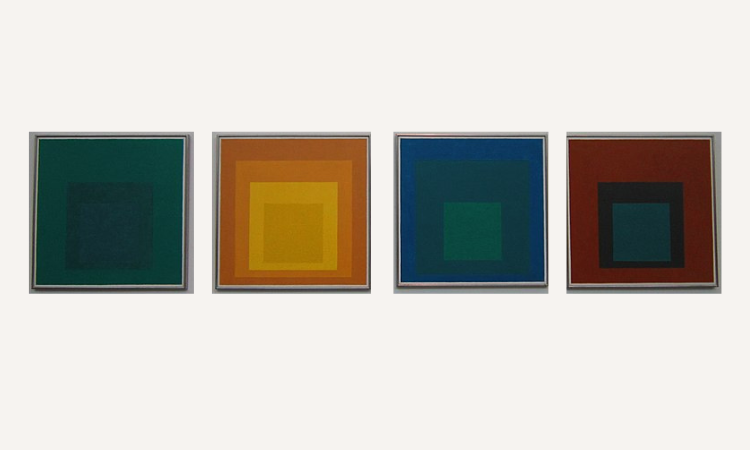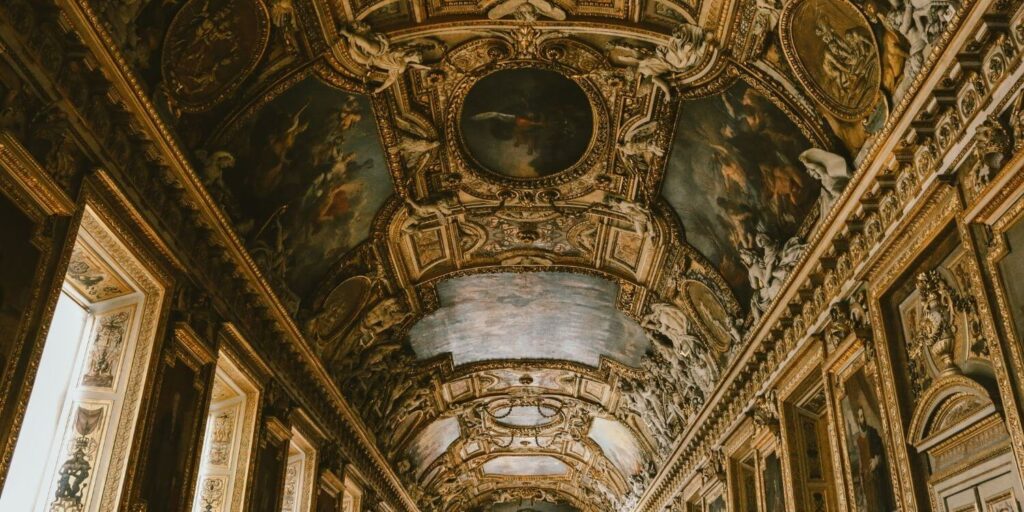
What is Abstract Art?
Art that does not attempt to represent an accurate depiction of visual reality but instead uses shapes, colors, forms, and gestural marks to achieve its effect. – Tate
In other words Abstract art is a style that doesn’t try to represent reality accurately but instead uses shapes, colors, and forms to sparks curiosity and emotion, often inviting viewers to interpret the work in their own way
To understand Abstract Art, one must first understand Art History. And once you know that, remarks like “my child could easily do that” would sound ridiculous. And then you’ll understand why it’s so valuable and why it’s worth so much.
From the pioneering works of Kazimir Malevich and Wassily Kandinsky to the expressive strokes of Jackson Pollock and Mark Rothko, these paintings have had a huge impact on the art world and continue to be admired by millions of people around the globe.
Here we go as we take a closer look at 10 of the most iconic abstract paintings of all times. Hopefully, this will inspire you to appreciate these incredible masterpieces in a whole new way.
The Persistence of Memory by Salvador Dali

“The Persistence of Memory” by Salvador Dali is a famous painting that has become one of the most iconic works of Surrealism. The painting, which was completed in 1931, features melting watches, distorted objects, and surreal elements that challenge the viewer’s perception of time and reality.
The painting depicts a landscape filled with surreal elements, such as melting clocks, distorted objects, and strange figures. At the center of the composition is a human face, whose features have been melting and distorted in a way that seems almost otherworldly.
The strange, dreamlike quality of the painting is enhanced by Dali’s use of vibrant colors and his careful attention to detail.
The uniqueness of the painting’s subject matter and its capacity to elicit a strong emotional response in spectators are two factors contributing to its popularity. The weird and unnerving melting watches and other warped objects in the picture give the observer a feeling of dread and bewilderment.
There are numerous ways to interpret what the painting might mean. According to some, the melting watches in the artwork are a metaphor for time, which is elusive and fluid and can appear to move faster or slower depending on how we perceive it.
Others think the melting timepieces represent the notion that time is unstoppable and that we have no control over it.
Overall, “The Persistence of Memory” is a complex and multi-layered painting that invites multiple interpretations and invites the viewer to think about the nature of time, memory, and reality.
“The Starry Night” by Vincent Van Gogh

“The Starry Night” by the Dutch Artist Vincent van Gogh is one of the most beloved and iconic paintings in the world. This beautiful painting, which was created in 1889, has captivated audiences with its swirling, expressive brushstrokes and its vibrant, glowing colors.
“The Starry Night” depicts a view of the village of Saint-Rémy-de-Provence in France, with the rolling hills and fields of the countryside bathed in a soft, golden light, which gives the painting a warm and inviting feel.
The sky is filled with swirling clouds and stars, which seem to dance and twirl across the canvas. One of the things that makes “The Starry Night” so special is the way that it captures the beauty and wonder of the natural world.
The swirling clouds and stars, the rolling hills and fields, and the glowing light of the village all work together to create a sense of awe and wonder that is truly breathtaking. It’s no wonder that this painting has become such an enduring classic!
There are a number of different interpretations of what “The Starry Night” might symbolize. Some people believe that the painting represents Van Gogh’s feelings of isolation and longing for connection, and that the swirling stars in the sky represent his own turbulent emotions.
Others have interpreted the painting as a representation of the eternal, cyclical nature of time and the way that it moves forward regardless of our own personal struggles.
Still others have seen “The Starry Night” as a commentary on the beauty and majesty of the natural world and the way that it can inspire feelings of awe and wonder in the viewer. The peaceful, serene atmosphere of the painting might also be seen as a metaphor for the way that nature can offer a sense of calm and perspective in the face of the chaos of everyday life.
“The Scream” by Edvard Munch

“The Scream” by Edvard Munch, the Norwegian painter is a famous painting that has become one of the most iconic works of modern art.
The painting, which was completed in 1893, depicts a figure with an anguished expression, surrounded by a landscape that is filled with swirling, turbulent clouds and a bright, glowing sky, which adds to the sense of tension and drama to mirror his distress. It has become a renowned painting for its emotional expression and representation of the human condition.
Munch was known for his unique and distinctive style, and “The Scream” is a perfect example to understand his style of work.
Through this Painting, Munch captures the raw, primal emotions of fear and anxiety in an Individual using bold lines and vivid colors. These colors and strokes give the subject a sense of energy and movement, and the distorted, abstracted forms contribute to its sense of unease and disorientation.
There are a number of different interpretations of what “The Scream” might symbolize. Some people believe that the painting represents Munch’s own feelings of anxiety and despair.
Others have interpreted the painting as a representation of the universal human experience of suffering and the way that we all feel overwhelmed by the world at times.
“Homage to the Squares” by Josef Albers

Homage to the Squares” by the German Artist-Josef Albers is an abstract oil painting series on Fibre board created in the year 1950.
The Homage to the Squares series consists of a series of paintings in which Albers used geometric shapes, specifically squares, to create a variety of optical illusions.
Each painting consists of several squares, each of which is painted with a different color. These squares are arranged in such a way that they create the illusion of depth, movement, and changes in color and value.
One of the main themes of the Homage to the Squares series is the interaction between color and form. Albers was interested in how different colors could be used to create the illusion of depth and movement, and how the placement of different colors next to each other could create the illusion of changing hues.
He also explored how the size and shape of the squares could affect the overall composition of the painting.
In addition to exploring the visual effects of color, Albers was also interested in the psychological effects of color. He believed that different colors could evoke different emotions and moods in the viewer, and he used this understanding to create powerful and evocative works of art.
Overall, Homage to the Squares is a beautiful and thought-provoking series of paintings that showcases Albers’ masterful understanding of color theory, his ability to use color to create optical illusions and evoke emotion in the viewer and his enduring influence on the art world
So, it is a great series to study and appreciate the art of color.
“Number 31” by Jackson Pollock

“Number 31” by the American Artist Jackson Pollock is a famous abstract painting that was created in 1950. It is part of a series of works by Pollock known as “drip paintings,” in which he used a drip technique to create the paintings, allowing the paint to drip and splatter onto large canvas in a seemingly random manner.
The resulting paintings are chaotic, expressive masterpieces that have made Pollock one of the most well-known abstract artists of all time.
One reason for “Number 31’s” fame is its unique and distinctive style. Inspite of the chaotic, seemingly random drips of paint thrown on a large canvas in a spontaneous manner, the resulting work is a powerful and emotive masterpiece creating the composition as a whole with a sense of unity and cohesiveness.
Pollock was a prominent figure in the abstract expressionist movement, The painting is filled with thick, bold lines and drips of paint that seem to swirl and dance across the canvas.
He did not typically attach explicit meanings to his works, instead allowing the viewer to interpret them in their own way. Pollock believed that this method of painting allowed him to tap into his unconscious mind and create works of art that are more authentic and expressive.
One of the most striking features of Number 31 is its vibrant and dynamic composition.
Number 31 is a powerful and expressive work of art that showcases Pollock’s innovative approach to painting and his ability to create dynamic and expressive compositions.
“Tableau I”, by Piet Mondrian

“Tableau I” is an iconic abstract painting by the Dutch artist Piet Mondrian. It was created in 1921, and is considered one of the defining works of the De Stijl movement, which was a Dutch artistic movement that focused on abstract forms, geometric shapes, and the use of primary colors.
In “Tableau I,” Mondrian uses a combination of straight lines and right angles to create a series of interlocking geometric shapes. The painting is divided into a grid-like structure, with each section filled in with a different color. The colors used in the painting are limited to just three primary colors – red, yellow, and blue – along with black and white.
Another reason for the painting’s fame is that it is a key example of Mondrian’s contributions to the development of abstract art. Mondrian was a leading figure in the De Stijl movement, which sought to create a new form of abstract art that was based on pure, geometric forms and primary colors.
Tableau I is a prime example of this approach, as it uses simple, geometric shapes and a limited palette of colors to create a powerful and expressive composition.
As a result, Tableau I is considered a classic work of modern art and continues to be admired and studied by artists and art lovers around the world.
“The Red Balloon” by Paul Klee

“The Red Balloon” by Swiss artist Paul Klee is a famous abstract painting that was created in 1922. It features a series of simple geometric shapes and a single red balloon. The painting has become famous for its playful, childlike quality and its use of color to create a sense of movement and energy.
Klee was a prolific artist who was known for his highly imaginative and expressive works of art, which often featured bright colors, simple forms, and surreal imagery.
“The Red Balloon” is an example of Klee’s imaginative and playful style, and it is a beloved work of art that has been widely reproduced and admired. The painting depicts a large red balloon floating in the air, surrounded by a few wispy clouds and a bright blue sky. The balloon is attached to a string that disappears off the bottom of the canvas, giving the impression that it is being held by an unseen person.
One of the main themes of “The Red Balloon” is the sense of wonder and whimsy that it evokes. The bright red balloon, with its round and cheerful shape, is a symbol of childhood joy and playfulness. The blue sky and clouds in the background add to the sense of wonder and freedom, as they suggest the vast and open expanse of the sky.
Another important theme of “The Red Balloon” is the idea of imagination and the power of the mind to create and experience joy. The balloon itself is an imaginary object, and it serves as a reminder that the world is full of endless possibilities and opportunities for wonder and joy.
Klee was a prominent figure in the Expressionist movement, and his work is known for its use of color, line, and form to convey emotion and meaning.
“The Black Square” by Kazimir Malevich

“The Black Square” is an abstract painting that was created in 1913 by was a Russian avant-garde artist and art theorist, Kazimir Malevich
It was created at a time when many artists were rejecting traditional forms of representation and seeking to create a new, abstract art. Malevich was a leading figure in this movement, and “The Black square” is considered one of the most important works of the Suprematist movement.
“The Black Square is an abstract painting that does not depict anything from the physical world, and as such, it does not have a specific symbolic meaning. Malevich believed that abstract art was the highest form of art, and he sought to create works that were free from any representational elements. The black square in the painting is a pure abstraction, and it does not represent anything in the physical world.
However, “The Black Square” can be interpreted in a variety of ways. Some viewers may see it as a symbol of the void or emptiness, while others may see it as a symbol of the infinite or the unknown. Still others may see it as a symbol of power or authority, as the black square takes up a prominent position in the center of the canvas.
Ultimately, the meaning of “The Black Square” will depend on the viewer’s interpretation, and the painting can be seen as a blank canvas on which viewers can project their own ideas and feelings. So, it is open to interpretation and can be seen as a symbol of anything the viewer desires it to be.
“Composition VII” by Wassily Kandinsky

“Composition VII” by Wassily Kandinsky is a famous abstract painting that was created in 1913. It is a highly complex and expressive work that is known for its bold use of color and its dynamic composition.
The shapes are abstract and geometric, and they are arranged in a seemingly random and chaotic manner. The colors are bold and vibrant, and they range from bright reds and yellows to deep blues and purples.
The painting has become one of the most well-known and influential works of abstract art in the world. There are many meanings associated with this painting. For the Art Historians, the work is a combination of the themes of Resurrection, Judgment Day, the Flood and the Garden of Eden.
Kandinsky did not typically attach explicit meanings to his works, instead allowed the viewer to interpret them in their own way. The painting is large, measuring 78.25 by 119.1 inches, and it is in the State Tretyakov Gallery in Moscow.
“Black on Maroon” by Mark Rothko

Black on Maroon is an oil painting on canvas by the Latvian-born American artist, Mark Rothko created in 1958.
“Black on Maroon” is a prime example of Rothko’s abstract expressionist style, and is one of three canvases created by Rothko in 1958 as part of a commission for murals for The Four Seasons Restaurant.
As is suggested by the work’s title, this is overlaid with a large black rectangle, which in turn encloses two slimmer, vertical maroon rectangles, suggesting a window-like structure. The black paint forms a solid block of colour but the edges are feathered, blurring into the areas of maroon. Different pigments have been used within the maroon, blending the colour from a deep wine to a muted mauve with accents of red. This changing tone gives a sense of depth in an otherwise abstract composition.
One of the main themes of “Black on Maroon” is the use of color to evoke emotion. Rothko believed that different colors could have different emotional effects on the viewer, and he used this understanding to create works of art that were deeply evocative. In “Black on Maroon,” the deep black and maroon colors create a sense of drama and intensity, and the smooth feathered color transitions add to the sense of unity and harmony.
The murals were eventually kept from being installed at the restaurant, reportedly because Rothko did not believe it was an appropriate setting for the works. In 1965, he proposed making them a gift to the Tate Gallery, which was approved in 1969. Rothko was discovered dead in his studio on the day of their delivery in 1970.
Conclusion
As we have seen, abstract art has a long and rich history, and it has produced some of the most iconic and influential paintings of all time.
These paintings are some of the most well-known and influential works of abstract art in the world, known for their unique styles, technical mastery, and cultural significance, and they continue to be admired by art lovers around the world.
But what exactly makes an abstract painting really interesting? Is it the vibrancy of the colors, the complexity of the composition, or the emotional impact created in a painting? Or is it something entirely different? These are questions only you can answer, and each person must decide what they value in an abstract painting.
So, as you continue to explore and appreciate the world of abstract art, keep an open mind and be willing to challenge your own preconceptions. Who knows what amazing and unexpected works of art you might discover along the way?


